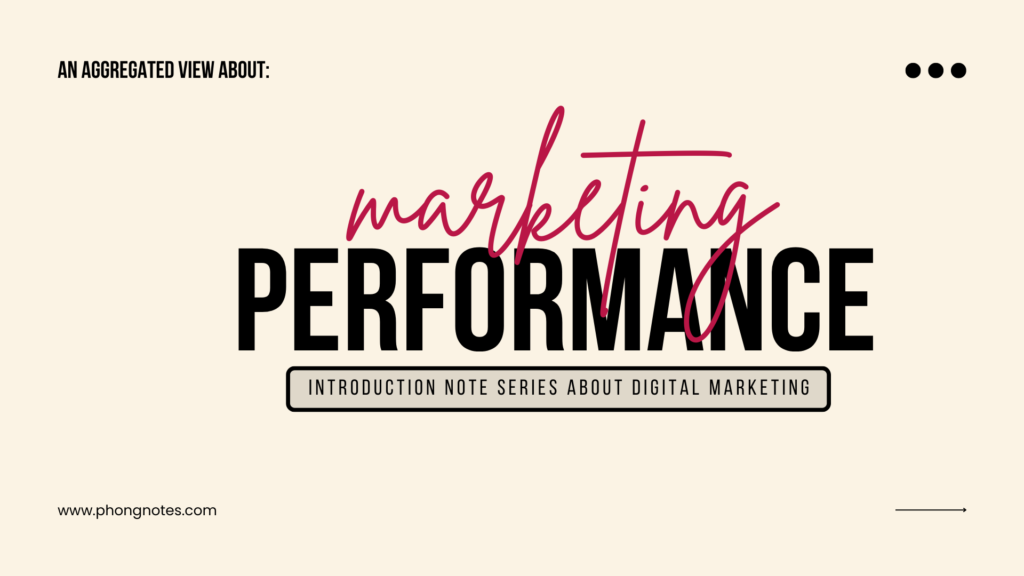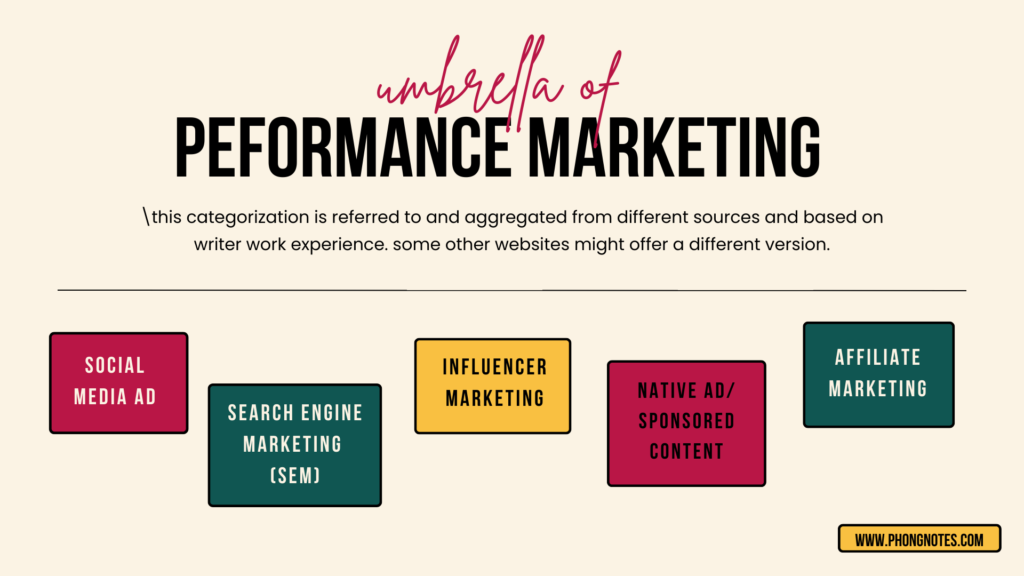Along three decades of digital marketing, performance marketing is the term that has been coined over fifteen years. Nevertheless, it has kept up with the leaps in technology and changed the way we perceive and conduct marketing campaigns. Given that performance marketing serves as the depth of marketing in the XXI century as each business decision is more data-driven.
In my work, I realize more colleagues don’t have a clear understanding of digital marketing and its features. Or they, and even me, sometimes experience a misunderstanding between definitions. This series of notes, therefore, is another chance for me to refresh and update fundamental definitions and its changes. What I do is that: I simply read, collect all contemporary sharing on the internet, cross-check with my own broad experience to aggregate.
Performance marketing definition
Performance advertising, known as pay for performance advertising or performance-based marketing, is a form of online advertising in which the advertiser/ service purchaser only pays when there are measurable results.
In a word, one action is manifested to process payment only when there is any specific result such as: clicking a button, downloading a brochure, or filling in a form recorded successfully.
From a practical perspective, the term refers to paid marketing campaigns. Although other types of digital marketing, such as organic media or SEO, can certainly drive sales, the feedback loops on these services are too slow to be considered true performance marketing campaigns. As long as campaign decisions are made based on measurable results, they can be considered performance marketing.

Performance marketing types
Based on popular channels where ads are normally placed, they divide performance marketing into 5 types. They are social media, search engines, videos, embedded web content, and more. References from Shopify and simplilearn.
Social media
Considered the most powerful channel currently as it offers not only the chance to reach diversified user demographics and drive them to your site – users can also share your sponsored content organically, extending your reach far beyond the original post.
While Facebook has the most extensive list of services to offer other opportunities to reach different shared-interest groups of users, other renowned channels focus on niche markets such as LinkedIn professionals for career development; Instagram for Millenials and Gen Z mainly who prefer lifestyle, and quick news updates or Twitter for media agents.
Search engine marketing
Most of the research is done via search engines. That means having a site that is optimized for search engine marketing (SEM) is essential. The main search engines are Google and Bing. Regarding performance marketing, the focus here is primarily on cost-per-click (CPC), especially for paid advertising. For organic SEM, many performance marketers rely on content marketing and optimized landing pages for SEO targets. To note, SEO which is about organic search engine optimization is different from SEM, literally based on paid search.
Influencer marketing
Historically, influencer marketing is not considered performance marketing. However, in recent years, that is changed. Influencers have gotten more business savvy, and the advent of influencer partnership platforms has activated brands to properly track and iterate on their influencer partnerships, making them truly performance-driven. It can be considered one types of Affiliate marketing.
Native advertising/ sponsored content
Similar to influencer marketing, instead of paying an influencer to promote an experience about your brand, you pay a publication to write about it. You need and have the power to control creativeness over what they speak or publish for you. Some publications call it native advertising, others sponsored content. Note that in most countries, publications have a regulatory requirement to disclose that the content is sponsored.
Affiliate marketing
is a model in which an affiliate earns a commission for marketing a company’s product or service. That commission is a compensation company pays affiliate partners (mainly publishers or blogs..) for promoting a product/service and the commission fee incentivizes affiliates to find a way to do it.
This categorization is relative. Each category is partly related to another, and it evolves itself according to actual business practices and tech advent. For instance, besides branding purposes, now more brands would rather contract a more performance-based deal with influencers as one of their affiliate programs. Or lots of affiliate marketers run social media and paid search ads to drive more traffic to their websites initially.
To differentiate each format, ad network and third-party tracking platforms contribute to facilitating campaign setup and tracking performance. That’s the reason why advertising technology (Adtech) joins the game.

Metrics and pricing model
Basically, regarding users’ actions, different metrics were generated. Marketers use those metrics to track performance and manifest for payment. As users’ behaviors changes and advent of new tracking methods, the metrics tend to be changed accordingly. Currently, they include:
Cost per Impression – CPM
i.e cost per mile, or cost per thousand. It is the cost the advertiser pays for 1000 impressions of a digital ad. This metrics targets on branding awareness. As it just measures the number of ad shown to target audience, no action required, some marketers are targeting more concrete or action-based metrics, not CPM.
Cost per click – CPC
Denotes the price paid for everytime a viewer clicks on an ad. CPC is a better indicator of engagement than CPM because the viewer at least take an action: clicking on the banner or headline/ tittle. A higher CPC usually means the value of the conversion is higher or or the targeting audience is niche, more difficult to reach.
Cost per action – CPA
Basically, CPA measures campaign performance according to specific desired action advertiser wants the target audience to take, such as downloading an ebook, signing up or subscribing, visiting your blog; filling a form (Cost per lead – CPL) or purchasing an item (CPS) …. Because of the wide range of actions, CPA is one of the most essential and versatile metrics used.
Sometimes, it can be misconstrued as cost per acquisition (CPA) which is a financial metric that measures the costs of acquiring one paying customer.
Lifetime value – LVT
predicts the entire spend of an individual customer during their entire relationship with a brand or company.
Thanks to increasingly sophisticated measurement capabilities, LVT is fast becoming a popular metric. It helps marketers plan their overall strategies towards the ultimate goal of boosting ROI. LVT estimates the expected spend of acquired customers based on their ongoing activity, using advanced methods like predictive analytics.
It is common for prices to be set through some form of bidding or auction arrangement. The advertiser can manage their budget and the set price of each unit. They states how much they are willing to pay for a user action, and the publisher provides feedback on how much other advertisers have offered. The actual might be lower or higher than the amount bid. Bidding strategies are up to demand side platforms (DSP) such as Google or Facebook at specific time.
Conclusion
To my observation, digital marketing has changed a lots within ten years as it grows in deeper and wider level. More technologies have been deployed to intergrate channels and improve campaign performance. All terms above-mentioned are possibly outdated within next five years. Nevertheless, let’s embrace the changes and chances.
Norwich, May 2022
Kate N.